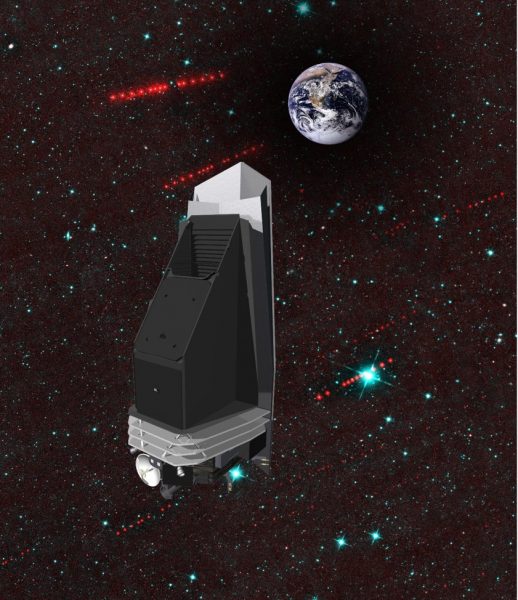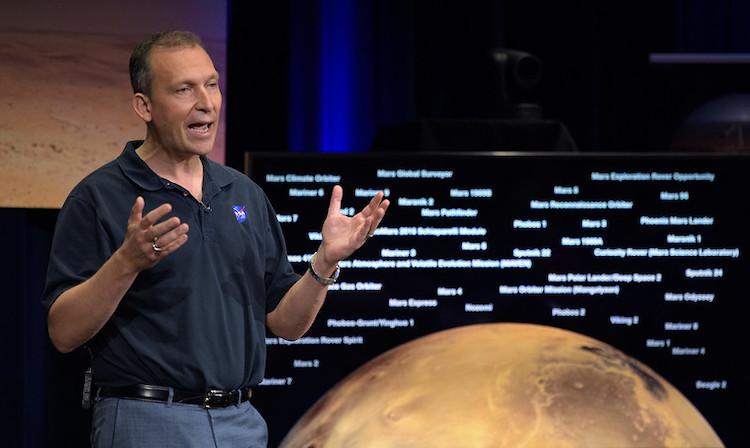NASA to proceed with asteroid surveillance mission – Spaceflight Now

After years of studies, NASA plans to move forward with a space-based telescope that could launch as soon as 2025 to scan the solar system for asteroids that could be on a collision course with Earth.
The Near-Earth Object Surveillance Mission will be NASA’s first space telescope dedicated to finding potentially hazardous asteroids. It builds on development work already accomplished on NASA’s Near-Earth Object Camera, or NEOCam, project, which has never progressed into full development after more than a decade of proposals, concept studies and prototype testing.
Thomas Zurbuchen, the head of NASA’s science mission directorate, announced the agency’s plans to proceed with the NEO Surveillance Mission on Sept. 23.
In 2005, Congress directed NASA to detect, track, catalogue and characterize 90 percent of the near-Earth objects equal to or greater than 140 meters, or about 460 feet, in diameter by the end of 2020. NASA will miss that goal because of a lack of funding.
Scientists estimate there are nearly 25,000 near-Earth asteroids on orbits that bring the objects relatively close to Earth, according to Lindley Johnson, NASA’s planetary defense officer.
As of last month, astronomers have discovered 8,778 near-Earth asteroids at least 140 meters in size.
“So we’re about 35 or 36 percent complete with the population after all these years of work,” Johnson said Sept. 24 during a meeting of NASA’s Planetary Science Advisory Committee.
Ground-based telescopes are the workhorses in the search for near-Earth asteroids, but they come with limitations. Bad weather limits their observing time, they are prone to equipment failures, and astronomers working in other disciplines compete for access to ground-based observatories.
“Our discovery rate with the current capabilities is probably going to remain at slightly less than 500 (per year), or around 500 (per year),” Johnson said.
“This discovery rate will probably tail off unless we do something to improve the capabilities,” Johnson said. “So at this discovery rate, we’re going to be another 30 years trying to reach the congressional goal of finding at least 90 percent of the 140-meter or larger (objects).”
A 140-meter asteroid striking Earth could devastate an area the size of a small country.
Zurbuchen said Sept. 23, at the same PSAC meeting, that the new NEO Surveillance Mission could launch as soon as fiscal year 2025 at a cost between $500 million and $600 million. The new space-based infrared telescope will accelerate the projected time required to find 90 percent of the near-Earth objects at least 140 meters in diameter by 15 years, he said.
“What are the mission objectives? We’ll find 65 percent of the undiscovered bodies with dimensions of 140 meters or more in five years (after launch), 90 percent in 10 years,” Zurbuchen said.

“How will a thing like this look? … At its heart is an infrared instrument,” Zurbuchen said. “It’s a heritage spacecraft, an observatory compatible with a launch vehicle such as a Falcon 9 or an Atlas 5-401, or a similar class, whatever might be available. A wet mass of about a metric ton, or a little bit above.”
The NEO Surveillance Mission, or NEOSM, will be stationed at the L1 Lagrange point nearly a million miles (1.5 million kilometers) from Earth in the direction of the sun. The observatory’s telescope will have an aperture of 19.7 inches (50 centimeters), and the mission will carry infrared detectors that are passively cooled without the need of a cryocooler, Zurbuchen said.
NASA’s Jet Propulsion Laboratory will oversee development of NEOSM.
JPL was the headquarters for the science team behind NEOCam, a concept similar to the NEO Surveillance Mission. NASA funded technology development work on NEOCam to build infrared detector prototypes and refine the design of the telescope’s focal plane.
Scientists proposed the NEOCam mission for funding in NASA’s Discovery program in 2006, 2010 and 2015, but NEOCam never received approval to proceed into full-scale development and launch. In the last Discovery mission selection, NASA chose to approve the Lucy and Psyche missions to travel to asteroids for up-close observations, but the agency opted to fund NEOCam for an “extended Phase A” period to continue development at a slower pace.
NASA’s Discovery-class projects are cost-capped robotic solar system exploration missions, and NEOCam — a telescope positioned closer to Earth — did not perfectly align with the Discovery program’s objectives.
A non-profit named the B612 Foundation announced plans in 2012 to develop a privately-funded space telescope to search for potentially hazardous asteroids. But the foundation encountered setbacks in fundraising, and NASA discontinued an agreement to provide non-financial support for the private space telescope in 2015.
Meanwhile, the budget for NASA’s planetary defense program has ramped up in the last few years. In fiscal year 2019, NASA received $150 million to spend on planetary defense initiatives, and the agency requested the same budget level in fiscal 2020.
Much of that funding is currently going toward NASA’s Double Asteroid Redirect Test, or DART, mission set for launch in July 2021. The DART spacecraft will intentionally collide with a small asteroid moon circling a larger body to demonstrate the effects of a guided impact on the object’s orbit.
If astronomers detect a threatening asteroid, a kinetic impactor like the one to be demonstrated on the DART mission could nudge the asteroid’s trajectory enough to avoid a collision with Earth.
The budget line for planetary defense breathes new life into missions like NEOCam.
“Planetary defense is important to NASA science,” Zurbuchen said. “It’s really critical for us, and I just want to say that I fully expect the scientists that were originally part of NEOCam will play a critical role in this … It’s that leadership that brought them this far, so we’re not going to mess that up.”
Amy Mainzer, NEOCam’s principal investigator, thanked Zurbuchen for NASA’s new emphasis on planetary defense.
“I know it’s been a huge effort, and you’ve really put a lot of effort into bringing planetary defense forward and helping to clarify the mission and its purpose, and I think thats a really good thing,” she said at the PSAC meeting. “It sounds like, with this, we have a path forward … We’re really excited to be part of the mission. and I’m confident we can work something out.
“Not only that, it is absolutely the case that these surveys generate huge rich data sets that we mine for decades and decades, and find all kinds of fun and interesting stuff for many different types of investigations, whether it’s more of an applied science effort, or something thats purely curiosity driven,” Mainzer said.
Email the author.
Follow Stephen Clark on Twitter: @StephenClark1.






